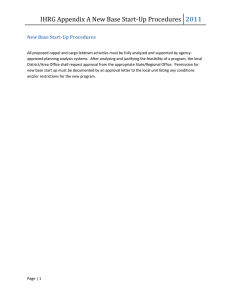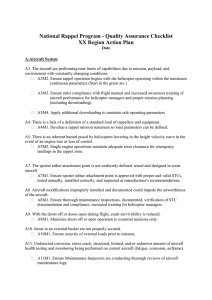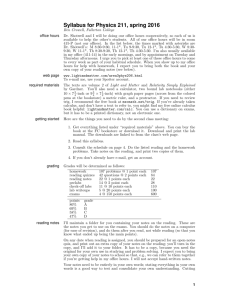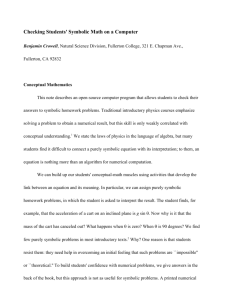IHRG Appendix E - Helicopter Spotter Training 2011 Appendix E. Spotter Training
advertisement
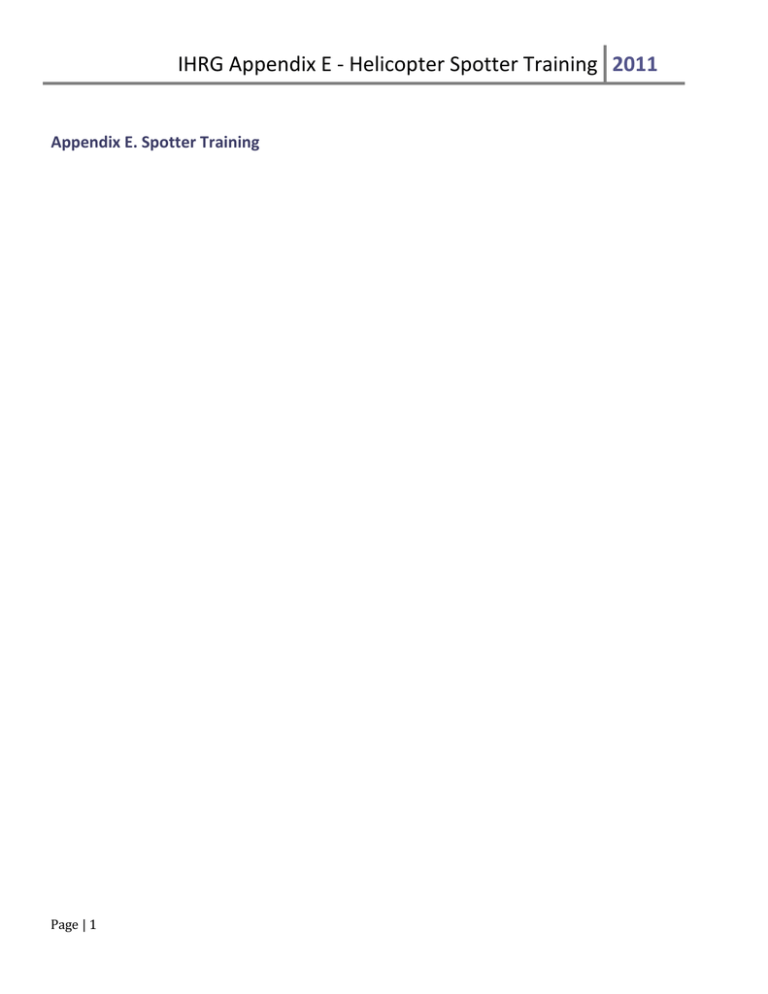
IHRG Appendix E - Helicopter Spotter Training 2011 Appendix E. Spotter Training Page | 1 IHRG Appendix E - Helicopter Spotter Training 2011 Lesson: INTERAGENCY HELICOPTER RAPPEL SPOTTER TRAINING 1 - Introduction Objectives: Recognize a standard format for cargo letdown/rappel spotter training. Training Aids: Interagency Helicopter Rappel Guides, Optional PowerPoint Presentation. Lesson Outline 1. Introduction The spotter is the key position in ensuring the safe deployment of rappellers. Decisions made by spotters can determine the success or failure of the mission. It is therefore essential that a spotter is well trained, proficient and competent in their role. 2. Lesson Agenda a. b. c. d. e. f. g. h. Page | 2 Lesson 1 Lesson 2 Lesson 3 Lesson 4 Lesson 5 Lesson 6 Lesson 7 Lesson 8 Policy and Procedures Documentation and Administration Hazards, Limitations Communications Equipment Cargo Letdown Rappel Spotter Simulated Mission Key Points Instructors should utilize personal experience as training aids. Note: The Spotter Training Record book will be used in conjunction with this training. IHRG Appendix E - Helicopter Spotter Training 2011 Lesson: INTERAGENCY HELICOPTER RAPPEL SPOTTER TRAINING 2 – Policy and Procedures Objectives: Discuss how to maintain compliance with all applicable agency and/or interagency policies and procedures. Training Aids: IHRG, applicable Agency Manuals/Handbooks, Unit Fire Management Plan, Unit Aviation Plan, Base Operations Plan, Rappel Operations Plan, Agency Aviation Accident Prevention Plan, National and GACC MOB Guides, Job Hazard Analysis Spotter Training Record. Lesson Outline Key Points 1. Policy a. Interagency Helicopter-Rappel Guide contains requirements for: i. Spotter prerequisites ii. Spotter training requirements iii. Fitness standards and requirements iv. Proficiency requirements b. Agency specific regulations and policy 2. Procedure a. Applicable portions of Unit Fire Management Plans. b. Base Rappel Operations Plan. c. Initial attack dispatch procedures. d. Off forest rappel procedures. e. Large incident operations f. Standard initial attack loads (numbers and equipment) g. Training and proficiency schedule. h. Booster rappellers plan (if applicable.) Page | 3 IHRG Chapter 2.3.2 Spotter Training Record book IHRG Appendix E - Helicopter Spotter Training 2011 Lesson: INTERAGENCY HELICOPTER RAPPEL SPOTTER TRAINING 3 – Documentation/Administration Objectives: 1) Identify proper rappel logbook and documentation forms. 2) Discuss the importance of timely and accurate rappel documentation as outlines in IHRG Chapter 4 Training Aids: IHRG Chapter 4, Appendix C Lesson Outline Key Points 1. Refer to Chapter 4 of the IHRG 2. Logs and Record Keeping 3. Ensure appropriate equipment and rappel logs are current and maintained. Reference Chapter 4 of the IHRG. IHRG Appendix C Applicable records and logs. Instructor should stress the importance of keeping thorough and up to date equipment, training and operations logs. Page | 4 IHRG Appendix E - Helicopter Spotter Training 2011 Lesson: INTERAGENCY HELICOPTER RAPPEL SPOTTER TRAINING 4 – Hazards, Limitations Objectives: 1) Discuss and interpret potential hazards encountered during rappel operations. 2) Demonstrate risk management evaluation skills. Training Aids: SAFECOM’s, IHOG, Flight Manual, IRPG, IHRG Lesson Outline Key Points Emergency Challenge 1. Hazards Response/Risk a. Discuss hazards that could have an impact on rappel operations. These include but and Management. are not limited to: Model specific i. Weather conditions 1. Pilot and spotter should look for weather and wind signs that could limitations. indicate turbulence or downward movement of air at destination. Discuss mission options. a. A good indicator on fires is the smoke column; is it shifting Off loading of some direction, laying horizontal or blowing downhill? Is it personnel and/or cargo. plume dominated? b. Are there thunderstorms in the area? Choose an off-site c. Is there increased turbulence when flying on the lee side of landing and have personnel hike to the ridges or geographical prominences? incident. Any of the above conditions may be an indicator of hazardous landing, rappelling, or firefighting conditions. ii. iii. iv. v. vi. vii. viii. Visibility Terrain Shadows Equipment Malfunctions (rappeller/spotter) Equipment Malfunctions (helicopter) Fire behavior Review SAFECOM’s b. Stress to trainee that even through the pilot has the ultimate responsibility for mission safety, the spotter must use sound judgment and abort the mission if conditions exist that he/she deems unacceptable or unsafe. 2. Mission Limitations a. Discuss the effects the following can have on mission success: i. Altitude ii. Temperature iii. Payload iv. CG v. Fuel Load vi. Pilot limitations (fatigue, etc.) b. Crew limitations (fatigue, “Can Do” attitude, etc.) Page | 5 Move site selection to achieve better helicopter performance. Refuse assignment, suggest other options. Utilize PC project/large monitor to present pictures/video of past rappel fires. Have trainees study pictures and/or video to simulate: Size-up to dispatch. Proper site selection with pilot and rappellers. Address risk and hazards that may be present to the helicopter and rappellers IHOG Chapter 6-1 Weight and Balance Calculations IHRG Appendix E - Helicopter Spotter Training 2011 Lesson 4 – Hazards, Limitations – (Continued) 3. Risk Management a. Review the rappel risk management for fire missions. b. Stress the importance of following a procedure for sound risk management in all aspects of a mission. c. Perform pre-flight risk assessment and mitigation to include manifests, load calculation, weather, fuel quantity, flight hazards, and communications. d. The GAR Risk Assessment model may be used as a deliberate risk assessment tool for mission planning purposes. e. After Action Reviews (AAR)-Stress the value of utilizing AAR as part of good risk management. Page | 6 IHOG Chapter3-1 Spotter Risk Management Training Program Emergency challenge and Response/Risk Management Appendix M GAR Risk Assessment Model. IHRG Appendix E - Helicopter Spotter Training 2011 Lesson: INTERAGENCY HELICOPTER RAPPEL SPOTTER TRAINING 5 – Communications Objectives: 1) Demonstrate proper hand signals for communications with rappeller without error. 2) Discuss guidelines for proper communications with area dispatch. 3) Demonstrate ability to effectively communicate verbally between pilot/spotter and non-verbally between rappeller/spotter. Training Aids: IHRG Chapter 5, simulation cards, etc. Lesson Outline Key Points Model specific 1. Pre and Post Mission Briefings procedures. Pre and post mission briefings between the pilot, rappellers and spotter are essential. IHRG Chapter 5.7 Items to be identified in the briefing include: Hand signals. a. What is the mission? b. Where is the mission? Simulated c. Potential hazards dispatch and d. Pre-flight and in-flight checks. simulated rappel. e. Trigger points for aborting the mission f. Emergency procedures Emergency and standard 2. Pilot/Spotter Communications challenge and response/risk Challenge and Response is a required communication procedure between the spotter and rappeller. Throughout the rappel process “go” or “no go” decisions must be relayed before management. proceeding to the next step. Generally C/R is a simple response needed from the pilot Trainer will use before the spotter can complete a step in the rappel sequence i.e., spotter states “main current challenge and tail are clear, move right 30 feet.” During the rappel sequence there are critical times and response when the spotter needs specific information from the pilot. document as a training aid to An example of this is prior to sending rappellers the spotter and pilot must communicate ensure spotter will power settings are within limits. use standard communications. It is essential that the spotters and pilots use standard communications for all rappel operations. All communications must be clear, concise and understood. Some Note: It is terminology (i.e., “opening doors”) can be dependent on the make and model of important that the helicopter. However, the following standardized terminology is to be used during normal trainee rappel operations. understands the flight manual a. Directional movement power settings i. “Left” and limitations for ii. “Right” each specific iii. “Forward” model they work iv. “Back” Page | 7 IHRG Appendix E - Helicopter Spotter Training 2011 v. “Up” vi. “Down” Directional: Stating a directional distance will assist the pilot while over the rappel spot, i.e. Spotter may state “we are drifting, hold, main/tail are clear, move right 50 feet.” Lesson 5 – Communications – (Continued) b. Procedural i. “How’s the power?” ii. “Dropping rope bags” iii. “Rope bags on the ground” iv. “Rappeller(s) to the skids” v. “How’s the power?” vi. “Sending rappeller(s)” vii. Rappellers position(s) in relationship to the descent, i.e., “Halfway down.” viii. “Rappeller(s) on the ground.” ix. “Rappeller(s) off the rope.” x. “De-rigging (left/right) side.” xi. “Dropping rope (left/right) side.” xii. “Clear to depart.” with i.e. max temp, torque, or PSI. Based on helicopter limits temp/pressure/ torque,etc. IHRG Appendix E Reference flight following procedures AFF, 15 minute checkins, Air Attack 3. Spotter/Rappeller Communications between the spotter and rappeller are non-verbal. Hand signals are used in place of words. Therefore, the first step in establishing spotter/rappeller communications is to ensure the rappellers attention stays focused on the spotter. (Instructor demonstrates standard hand signals.) 4. Flight Following Communications Review standard flight following procedures. 5. Operational Communications Instruct trainee in pre/post rappel communications with dispatch, Helibase, etc. a. b. c. d. Page | 8 Size up Landing to configure (lat/long) Over rappel site; Adjust radios to reduce external distraction Rappel complete, establish communication with inserted rappellers, and ensure they have positive communications with dispatch, helibase, etc. IRPG Size Up IHOG Chapter 8 IHRG Appendix E - Helicopter Spotter Training 2011 Lesson: INTERAGENCY HELICOPTER RAPPEL SPOTTER TRAINING 6 – Equipment Objectives: 1) Identify rappeller/spotter equipment and demonstrate inspection and care of that equipment. 2) Recognize proper utilization and care of rappel equipment, including PPE. Training Aids: IHRG Chapter 3, MTDC web site: www.fs.fed.us/t-d/rappel/index.htm Lesson Outline Key Points 1. Inspection Spotter harness a. Review equipment requirements and standards in IHRG with tether. b. Instruct trainee in the proper methods of equipment inspection. i. If the helicopter is available instruct trainee in the proper methods of anchor and attachment point inspection. (If the helicopter is not available at this portion of the training, this must be covered prior to mock-ups.) ii. Stress to the trainee that even through the rappeller is responsible for inspection and maintenance of their equipment, that the spotter is ultimately responsible for monitoring the use and care of all rappeller/spotter equipment. All equipment requirements and standards can be found in the IHRG. Page | 9 Rappel and letdown equipment Model specific equipment Review anchor inspection requirements. IHRG Appendix E - Helicopter Spotter Training 2011 Lesson: INTERAGENCY HELICOPTER RAPPEL SPOTTER TRAINING 7 – Cargo Letdown This lesson can be taught as a standalone or be combined with Lesson 8 when the individual is being trained for both cargo letdown and Rappel Spotter concurrently. Objectives: 1) Describe the function of all cargo letdown equipment 2) Demonstrate proper model specific cargo letdown configuration. 3) Demonstrate proper cargo letdown procedures without error. 4) Demonstrate effective communications with pilot. Training Aids: IHRG, Model specific rappel procedures associated with cargo equipment. Lesson Outline 1. Ground Training a. Review model specific procedures. Familiarize trainee with equipment. Review applicable portions of IHRG. b. Familiarize trainee with spotter equipment checks and spotter “buddy check.” Stress that the spotter is responsible to ensure all equipment is in good condition and properly fitted. c. Cargo letdown training should be accomplished utilizing a rappel tower in addition to helicopter mock-ups, but utilizing helicopter mock-ups as the sole means of ground training is acceptable. d. Demonstrate anchor inspection. e. Demonstrate placement and securing of cargo. f. Demonstrate pre-flight checks i.e., spotter equipment check, hook checks, etc. g. Demonstrate cargo configuration procedures. h. Demonstrate cargo letdown procedures, including spotter/pilot communications, and emergency procedures. i. Trainee will perform anchor inspection, securing of cargo, cargo letdown procedures, spotter/pilot communications, including emergency procedures until instructor deems the competency level is accomplished. (Minimum of three (3) complete cycles without procedural error.) 2. Helicopter Deployment a. Under the supervision of a Cargo/Rappel Spotter, trainee will inspect equipment, prepare cargo load, configure the helicopter and deploy a minimum of ten cargo letdown cycles, without procedural error, at low, medium, and high heights. Five (5) of these deployments will be in typical terrain. Final evaluation will be completed by a Check Spotter. b. Should at any point during live cargo deployment the trainee makes repetitive procedural errors, the instructor will return the trainee to ground training for additional training. Page | 10 Key Points Gather cargo letdown equipment IHRG model specific procedures, Appendix B IHRG Chapter 5.3 The pilot(s) must be present during this phase of the training. Emergency Challenge and Response/Risk Management. IHRG Appendix E Rappel Spotter Training Record. IHRG Appendix E - Helicopter Spotter Training 2011 Lesson: INTERAGENCY HELICOPTER RAPPEL SPOTTER TRAINING 8 – Rappel Spotter If cargo letdown and rappel spotter are being taught concurrently, integrate Lesson 7-Cargo Letdown, with this portion of the training. Objectives: 1) Demonstrate proficiency (without procedural error) to successfully spot rappels from an elevated platform during training. 2) Spot 20 complete rappel cycles from the platform level. Five (5) consecutive loads shall be accomplished without procedural error and shall include cargo letdown. If a simulator accommodates two (2) rappellers, then that would count as one cycle. 3) Demonstrate ability to effectively communicate both verbally and non-verbally. 4) Spot a minimum of eight (8) mock-up cycles without procedural error. 5) Under supervision of qualified spotter, shall spot a minimum of 10 live cycles without procedural error at low, medium, and high (Appendix I) height. Five of these must be in typical terrain, and three (3) shall include cargo. Training Aids: IHRG Chapter 2, 5, 6, Appendix B Lesson Outline Key Points Review IHRG 1. Ground Training Appendix D a. Reference Appendix B model specific procedures. b. Familiarize trainee with spotter equipment checks and spotter “buddy check.” Emergency Stress that the spotter is responsible to ensure all equipment is in good condition Procedures IHRG and properly fitted. Chapter 6 c. Review applicable portions of IHRG for hand signals and emergency procedures d. Trainee must participate with the training of new rappellers. Recognize procedural errors 2. Low Tower and demonstrate a. Instructor will demonstrate rappel spotter procedures for low tower. effective i. Tether attached. communication ii. Rappeller buddy check completed. with trainee iii. Rappeller equipment check. rappellers to iv. Use appropriate hand signals to move rappeller(s) into position. include v. Final equipment check. constructive vi. Hand signal to send rappeller(s). feedback. vii. Emergency signals. b. Trainee will demonstrate the above until instructor deems the competency level needed to move to the high tower is accomplished. It is important that the trainee verbalize all actions including spotter/pilot communications. Page | 11 Review Emergency Challenge and IHRG Appendix E - Helicopter Spotter Training 2011 3. High Tower with Simulator a. Instructor will demonstrate: i. Anchor inspection. ii. Proper configuration of cargo for deployment (as appropriate by specific simulator) iii. Proper attachment of carabiners, ropes and snub strap to anchor points. Response/Risk Management. IHRG Appendix D Lesson 8 – Rappel Spotter– (Continued) iv. Proper sequence for loading rappellers including: 1. Attaching equipment 2. Completed buddy checks 3. Spotter check 4. Final checks prior to launch v. In flight procedures vi. Fire/rappel spot size up and evaluation vii. Selection of secondary site. viii. Contact with dispatch ix. Proper sequences for deploying cargo with rappellers. 1. Off site power check. 2. Setting up over rappel site. 3. Confirming mission is a go. 4. Use of hand signals to remove seat belts. 5. Use of hand signals to drop rope bags.* 6. Use of knot in rope signal and acknowledgement (if applicable) 7. Use of hand signals to send rappellers to skids. 8. Final checks 9. Use of hand signals to send rappellers. 10. Disconnecting and dropping ropes. 11. Cargo deployment 12. Departing rappel site and reestablishing communications. b. Trainee will demonstrate the above until instructor deems the competency level needed to move to emergency procedures is accomplished. It is important that the trainee verbalize all actions including spotter/pilot communications. 4. Emergency Procedures a. A spotter must be thoroughly familiar with and able to accomplish emergency procedures. The instructor will demonstrate using equipped rappellers, all established emergency procedures. Instructor will stress the importance of dialog between the pilot and spotter during emergency situations. It is imperative that the spotter retain control and composure during an emergency. b. The trainee will demonstrate using equipped rappellers all established emergency procedures. At a minimum, the IHRG requirements pertaining to this portion of Page | 12 *See model specific procedures. Re-entry/return to seat procedures to be included IHRG Chapter 6 Shall demonstrate competency in the execution of all aspects of emergency procedures without error as outlined in chapter 6 prior to helicopter deployment. Secondary restraint IHRG Appendix E - Helicopter Spotter Training 2011 the training shall be accomplished. It is important that the trainee verbalize all actions including spotter/pilot communications during this phase of training. 5. Mock-Ups a. Instructor will demonstrate anchor inspection, proper configuration of cargo and rappel equipment, loading of rappellers, cargo and rappeller deployment, including spotter/pilot communications and emergency procedures. b. Trainee will simulate deploying cargo and rappellers during mock-ups until the required minimum (eight (8) mock-up cycles without procedural error) has been accomplished. c. Highly recommended that scenarios are incorporated to enhance spotter training. Lesson 8 – Rappel Spotter– (Continued) 6. Helicopter Deployment a. Under the direct supervision of a rappel spotter, trainee will inspect equipment, prepare cargo load, configure the helicopter and deploy a minimum of ten rappel cycles, without procedural error, at low, medium and high heights. Five (5) of these deployments will be in typical terrain, three (3) shall include cargo and one (1) ETO. Final evaluation will be completed by a rappel checks spotter. b. Should at any point during live helicopter deployment the trainee makes repetitive procedural errors, the instructor will return the trainee to the appropriate level of training for review (ground, tower, mock-ups.) procedure post emergency. For quick helicopter egress, remember you and your rappellers are still tethered to the helicopter. The pilot (s) must be present during this phase of the training. Note: Whenever helicopter is in flight and doors are open or off, spotter or designated rappeller(s) are responsible for maintain hold on rope bag(s) until rope(s) are deployed from the helicopter. IHRG Appendix D Spotters Training Record. Page | 13 IHRG Appendix E - Helicopter Spotter Training 2011 Lesson: INTERAGENCY HELICOPTER RAPPEL SPOTTER TRAINING 9 – Simulated Mission Objectives: 1) Successful demonstration of spotter competency and knowledge. Training Aids: SAFECOM’s, Base operating plan, base rappel plan, pictures of past fires and fuel type and sand table. Lesson Outline Key Points Utilize PC 1. Simulation Logistics projector/large a. Instructor will pre-select a location for a simulated fire. monitor to b. Instructor will coordinated with local dispatch center, FMO and other necessary present personnel to facilitate a live training scenario. pictures/video of past rappel fires. 2. Tasks to be Completed a. Trainee will ensure that the helicopter and Initial Attack (IA) personnel are This section may prepared for an IA mission utilize Task 7 of b. Trainee will demonstrate the correct operational procedures to respond to an IA the Spotter dispatch call. Training Record. c. Trainee will assist pilot with navigation and communications while en route to simulated fire. Have trainees d. Trainee will provide a fire size up and other applicable information to dispatch. study pictures e. Trainee will demonstrate the appropriate procedure to prepare for a rappel i.e., and/or video to landing to configure, prepare cargo, etc. f. Trainee will successfully deploy a minimum of one stick of rappellers performing all simulate operational procedures. Size-up to g. Trainee will ensure deployed rappellers have established communications, redispatch. configure helicopter and return to base. 3. Post Mission a. Trainee will complete mission documentation forms and conduct AAR. b. Successful completion of the scenario does not replace a final evaluation by a check spotter. Page | 14 Proper site selection with pilot and rappellers. IHRG Appendix E - Helicopter Spotter Training 2011 Address risk and hazards that may be present to the helicopter and rappellers. Page | 15
